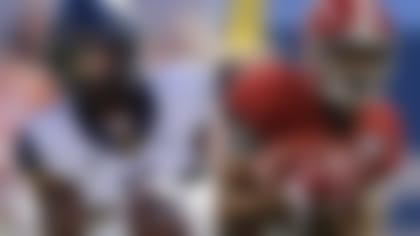If imitation is the highest form of flattery, then Pro Bowl wide receivers Andre Johnson and Larry Fitzgerald should be honored by the events set to take place on draft day.
Fueled by Johnson and Fitzgerald's success and the notable achievements of other big receivers in the NFL, teams are looking to stock their rosters with pass catchers who have the requisite size and athleticism to dominate on the edge.
Of the eight receivers on Pro Bowl rosters, six measured more than 6 feet in height (Steve Smith and Wes Welker were the exceptions), including all four starters (Fitzgerald, Johnson, Brandon Marshall and Anquan Boldin).
Draft series: Receivers
 NFL.com's 10-part series looks at each position in the draft.
Receivers package
» Video: Mayock's top five
» Photos: Top prospects
A glance at the top 10 receivers in terms of yards last season reflects the same trend. Seven of the 10 players could be classified as big receivers, and their success has scouts looking for the next "big" thing in this year's draft.
Fortunately, the 2009 draft class is loaded with "big" receivers. Led by first-round probables Michael Crabtree, Jeremy Maclin, Darrius Heyward-Bey, Hakeem Nicks and Kenny Britt, this year's class features several receivers who can control the game with their size and athleticism.
Crabtree, who measured in at 6-foot-2 and 215 pounds at the NFL Scouting Combine in February, has evoked comparisons to Fitzgerald with his play at Texas Tech. The two-time Biletnikoff Award winner seemingly made impossible catches look routine during his two seasons in Lubbock. Taking advantage of his superior size and athleticism, Crabtree frequently won jump balls over smaller defenders down the field, alleviating the pressure on quarterbacks to make perfect throws. That's important in a league with only a handful of franchise quarterbacks.
Nicks and Britt are other first-round prospects with the size and athleticism to make life easier for their respective quarterbacks.
Nicks, a 6-1, 212-pound playmaker from North Carolina, has mastered the art of using his body to create space while tracking balls down the field. His brilliant performance against West Virginia in the Meineke Car Care Bowl showcased that ability as he came down with numerous circus catches despite having defenders draped over him.
Britt, a 6-4, 218-pound talent from Rutgers, torched the Big East Conference by using his superior size advantage over smaller defenders. The first-team all-conference selection tallied 14 100-yard games during his Scarlet Knights career and has several NFL scouts envisioning him blossoming into a Plaxico Burress-type playmaker on the edge. The luxury of having a towering receiver on the outside gives creative offensive coordinators another option in critical red-zone situations.
However, the fastest-rising prospect on the draft board provides the best illustration of how scouts are looking for the next athletic phenom to impact the game. Heyward-Bey has risen up the charts based on his outstanding combination of height, weight and speed.
The former Maryland standout went from an unheralded second- or third-round prospect to a possible top-15 selection on the heels of an outstanding performance at the combine. The 6-2, 210-pound speedster clocked a stunning 4.30 seconds in the 40-yard dash and blew away the rest of the performance-testing drills in Indianapolis.
Though Heyward-Bey averaged more than 15 yards per catch in his college career and scored 13 touchdowns, he is regarded as an inconsistent pass catcher and lacks some of the key traits often associated with No. 1 receivers. But his superior size and athleticism has teams willing to take a major gamble on a player who looks like another "boom or bust" prospect from afar.
General managers and scouts often appear overly enamored with measurables, but the receivers in this year's draft class will provide another opportunity to see if the old adage that "bigger is better" still holds true when identifying pass catchers.













